Though 15 years have elapsed, I still remember the first time I drove a Toyota Prius. That car was wonderful, because it was so high-tech and so novel, and awful, because it was ugly, slow, handled clumsily, and rode noisily. Also, transitions between the conventional and electric systems for acceleration and braking were about as seamless as Frankenstein's sutures. The second-generation Prius, introduced as a 2004, was a far better car and became the first hybrid to sell in significant volume. The third-generation Prius, introduced as a 2010, was better still: quicker, more efficient, better handling, and much easier on the eyes than the first two. For 2016, Toyota has introduced a fourth generation of the car that popularized hybrids. I spent a week with the latest Prius to see if they've once again managed to improve it.
Until the Hyundai Ioniq arrives next year, the Prius has no recently updated direct competitors. Honda has discontinued both the Insight and the Civic Hybrid. The Chevrolet Volt runs most (even nearly all) of the time on battery power. I've already compared the two cars anyway. For this review I'll focus on the Prius's only current direct competitor, the Ford C-MAX, though it hasn't been updated since 2013.
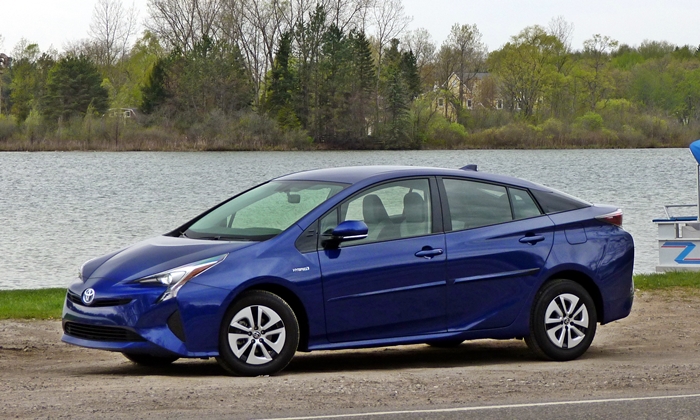
Toyota felt the need to add drama to the exterior of the new Prius. These wheel covers do not help. more Prius photos
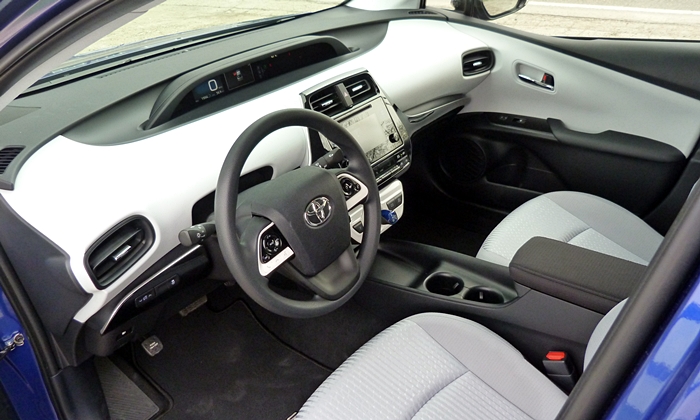
Futuristic high-contrast interior. Maximizes perceived room, but odd.
| |
Compared to the C-MAX |
| Fuel economy |
 Better
Worse
Better
Worse
|
The new Toyota Prius's EPA ratings are the best of any car without a plug: 54 mpg city, 50 mpg highway. Well, almost. That honor specifically goes to the Prius Two Eco, the variant I tested. With more battery-powered range, some aerodynamic enhancements, and a slightly lower curb weight, the Prius Two Eco scores 58/53.
The Ford C-MAX's EPA ratings aren't in the same league: 42/37.
When running on gasoline, the Chevrolet Volt doesn't test as well as the Prius: 42/43. But you can plug in the Volt for about 50 miles of electric-only range.
The new Honda Civic, among the most fuel-efficient non-hybrid compacts, manages 31/41.
In my real-world driving the Prius Two Eco easily beat its EPA ratings, at least in temperate weather. Driven with a very light foot on my standard suburban route, it twice averaged 93 mpg, easily the best in my testing of any car without a plug. When the air temperature dropped into the 40s, though, I couldn't quite manage 60 mpg. On a 70-mph highway in mild weather the Prius averaged just over 60 mpg. Overall for the week it averaged 65 mpg, nearly double the C-MAX and more than double the Civic.
My efforts were aided by some of the most thorough driving style feedback you'll find in a car. The Prius scores how you acclerate, cruise, and brake, and provides tips for improvement. It also stores your average mpg daily for a month, then monthly over a long time period.
| Reliability & durability |
 Better
Worse
Better
Worse
|
From the second generation onwards the Toyota Prius has been among the most trouble-free cars in TrueDelta's Car Reliability Survey. There's no reason to expect this to change with the redesign. The Civic has been nearly as good, while the C-MAX and Volt have beeen about average.
Because the Prius has a reputation for long-term reliability, it also depreciates much more slowly than the C-MAX and Volt.
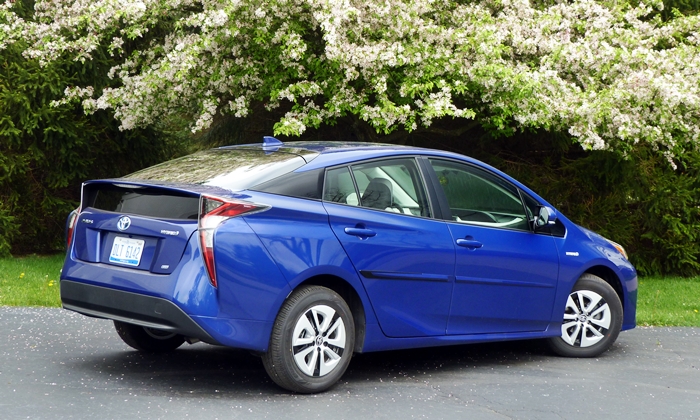
Overwrought rear fenders, blacked-out rear pillar, convoluted tail lamps. Not my favorite angle.
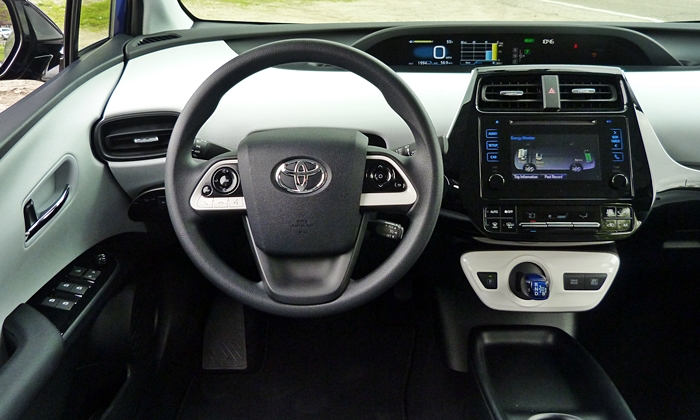
The controls are generally easy to reach and operate.
| Safety & braking |
 Better
Worse
Better
Worse
|
The new Toyota Prius aced its crash tests and is offered with a full array of effective safety tech. The Ford C-MAX managed only an "acceptable" rating in the challenging "small overlap" test (it scored well in the others) and isn't yet available with forward collision warning, automatic braking, or lane departure warning.
| Front seat room |
 Better
Worse
Better
Worse
|
For a compact hatchback, the new Toyota Prius feels very roomy inside. It helps that the tall, sloping console of the third-generation Prius has been replaced by one with a much less intrusive (if also less sporty) design. The deep instrument panel is scooped out on top, while the windshield is large and distant. The view forward from the driver seat is very open, but anyone who isn't a goldfish will find it unusual. It's like driving a spaceship, in two senses. Or a small minivan.
The Ford C-MAX has a crossover-like driving position and the most comfortable seats. The front seats in the Prius are nicely shaped, but less firm. Those in the Volt could use more contour. I found the Civic's front seats somewhat uncomfortable.
The Volt feels far tighter inside. Up front the windshield seems far smaller than that in the Prius. The back seat, while its cushion is comfortably positioned, threatens to induce claustrophobia.
Both the Prius and the Volt have restricted visbility to the sides and especially to the rear. The view is much better from the driver seat in the C-MAX.
| Ride smoothness |
 Better
Worse
Better
Worse
|
With the redesign, Toyota dramatically stiffened the body structure of the Prius and fitted it with a much more sophisticated rear suspension. As a result, the new Prius rides much better than the previous generation hatchback. The third-generation's tight damping and thumpy tires have been refined away without harming the car's handling. The opposite, even.
I also like how the C-MAX rides, though it's significantly firmer than the Prius. This shouldn't come as a surprising since the C-MAX was originally developed in Europe for European drivers.
Compared to that of the Prius, the Volt's suspension feels tighter and firmer. Its ride sometimes seems bumpy and its tires clomp much more loudly over bumps.
The new Prius is also much quieter than the previous one, but the Ford and Chevrolet are even quieter, at least on smooth roads that don't induce their tires to clomp.
| |
Compared to the C-MAX |
| Exterior styling |
 Better
Worse
Better
Worse
|
What's not to like about the new Toyota Prius? In a word, its styling. The third-generation car had a clean, pleasant shape and much better proportions than the hunchbacked second-gen. The fourth, in contrast, has unattractively busy, even tortured surfacing, especially on the rear fenders.
The Ford C-MAX isn't an attractive car, but at least it's not bizarre. A more attractive face has graced the European C-MAX for over a year, but hasn't made its way across the Atlantic yet.
The new Chevrolet Volt, though I don't care for the unresolved mess of lines and trim at the base of the front pillar, is easily the most attractive of the three.
| Interior styling |
 Better
Worse
Better
Worse
|
The Toyota Prius's future-modern interior styling also didn't quite work for me. The view from the driver seat borders on bizarre. Plus the seat fabric looks and feels economy-grade.
The C-MAX's interior is very much recent Ford (so business-like European, with better-than-average materials) while the Volt's is very much recent Chevrolet (pleasantly flowing forms, but with a cold, plasticky ambiance). Some people will find the interior styling of both boring, and prefer that of the Prius.
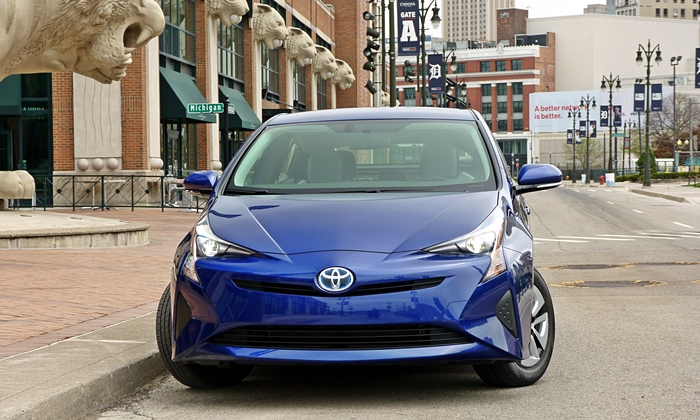
What do you see? What do you think of the Prius's new face?
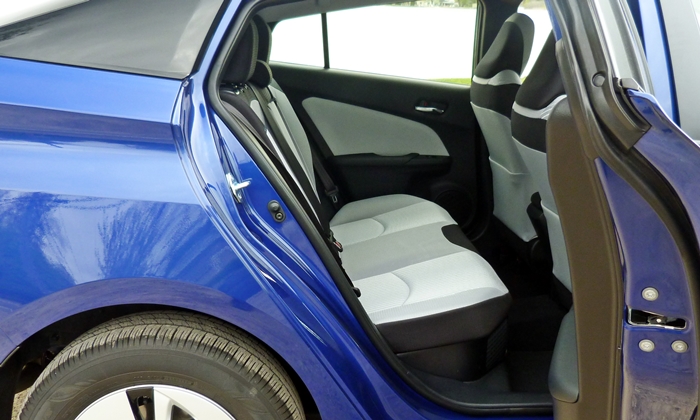
Good knee room, but barely adequate headroom despite low cushion.
| Powertrain performance |
 Better
Worse
Better
Worse
|
Drive the Prius for maximum efficiency, and you'll irritate whoever happens to be behind you. It feels most right when driven slowly, though.
In power mode with a heavy foot the Prius becomes reasonably quick, but with a rubber band effect to the powertrain operation. The lack of precise control over the gasoline engine can be disconcerting in spirited driving.
On the positive side of the ledger, engine noise is suppressed well and transitions between electric-only power and gas-plus-electric are far, far smoother than in the early Prius. It's often necessary to glance at the instrument panel to tell whether the gasoline engine is running.
The C-MAX's power delivery feels smoother and considerably stronger in typical driving.
The all-electric Volt is the champ in this area, though. The Chevrolet's electric motors, much stronger than those in the Prius, deliver their power almost instantaneoulsy in a smooth, nearly silent rush. Compared to that of the Prius, the Volt's acceleration feels much more effortless. In objective terms, it can get from a stop to 60 mph about two seconds sooner, about 8 vs. about 10, a big difference. The Ford splits the difference.
| Rear seat room & comfort |
 Better
Worse
Better
Worse
|
Rear seat passengers in the Prius have far more knee room than those in the Volt, and feel far less closed in. Despite a low-mounted seat cushion, though, headroom is limited.
Rear seat passengers in the C-MAX enjoy a much more comfortably positioned seat cushion, significantly more headroom, and better outward visibility.
| |
Compared to the C-MAX |
| Cargo capacity |
 Better
Worse
Better
Worse
|
For a hybrid, the Toyota Prius is unusually versatile, with more cargo volume than the C-MAX (with their seats folded, about the same otherwise) and much more than the Volt. The Prius Two Eco and the Prius Four have about three cubic feet more cargo capacity than other Prii because they have no spare tire.
| Handling |
 Better
Worse
Better
Worse
|
The redesigned Prius handles with significantly more precision and control. The steering remains light and nearly feedback-free, but at least it no longer feels like that of a video game.
The Volt's motions feel even better controlled, but it also feels heavier and less agile, and it doesn't ride as smoothly.
The C-MAX, though the heaviest of the three, drove the best for me. Like the Volt, it feels more solid and substantial than the Prius. The Ford's suspension controls body motions tightly and precisely, while its steering manages (unlike the systems in the other two) to feel somewhat sporty.
| Price or payments |
 Better
Worse
Better
Worse
|
Take the Chevrolet Volt's federal tax credit into account, but ignore other incentives, and the Toyota, Ford, and Chevrolet are all close in price once feature differences are accounted for. Discounts are likely largest on the Ford, since it is by far the oldest design. But the Prius is likely to depreciate the slowest and to require fewer repairs in the long-run, so, as mentioned when discussing reliability, it probably has the lowest total cost of ownership.
With excellent fuel economy and reliability, which in turn encourages strong resale values, the Toyota Prius has long excelled in terms of total cost of ownership. A redesign for 2016 has dramatically improved how well the Prius rides and handles, while further improving its fuel economy. During my week with the car I averaged an astounding 65 mpg. The new interior feels much roomier, especially in the front seat, and can also carry about as much cargo as the typical compact crossover.
What's not to like about the fourth-generation Prius? More than anything else, the new styling. But perhaps you'll like how it looks.
Beyond styling, the Prius doesn't sound or feel all that good when hustled. I enjoyed driving the sportier-handling Ford C-MAX quite a bit more. But the Prius isn't really intended for spirited driving. Drive the new Prius the way its engineers intended, and it feels very pleasant, even relaxing.
For commuting and the typical around-town tasks, you'll be hard-pressed to find a more sensible car.
The big question mark: how attractive is 50-plus-mpg fuel economy in an era of two-dollar gas? Many people will no doubt prefer the lower prices and superior performance of non-hybrid compact cars such as the Honda Civic, if they get a car rather than a crossover at all. The irony: Toyota has fielded the most impressive Prius to date at a time when the typical car buyer cares less about fuel economy.
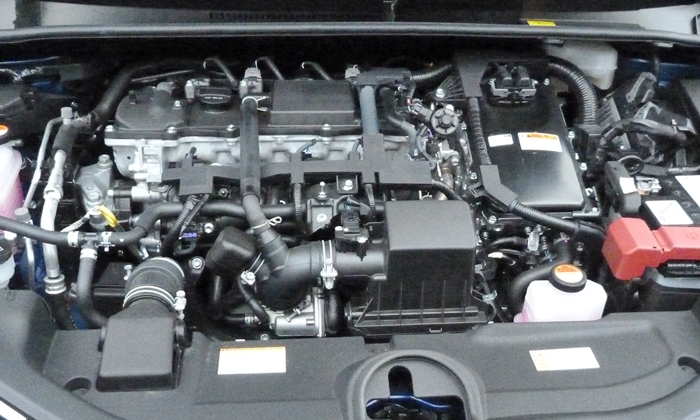
Easily the best fuel economy I've observed in a car without a plug.
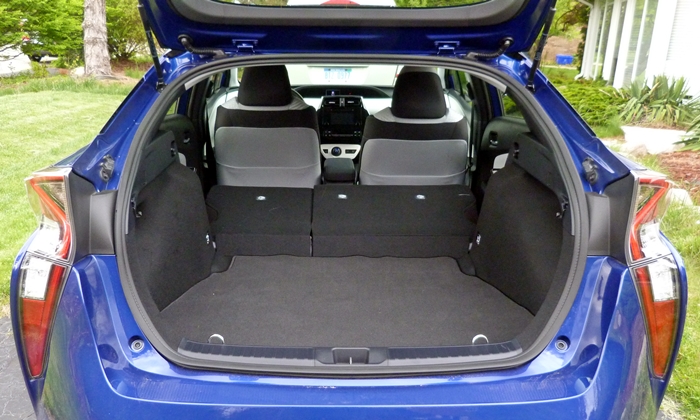
With the rear seats folded, your stuff will probably fit.
See more 2016 Toyota Prius photos
Toyota, Ford, and Chevrolet each provided a car for a week with a tank of gas. Matt Poches of Serra Chevrolet helpfully provided a second, 2017 Volt so I could drive it back-to-back with the Prius.











